HRM 591: Compensation Strategies, Motivation, and Evaluation
VerifiedAdded on 2023/05/28
|6
|1200
|208
Essay
AI Summary
This essay explores the multifaceted relationship between money and employee motivation, referencing Maslow's hierarchy of needs. It emphasizes the importance of equitable compensation systems, highlighting how organizations can design them using salary ranges and avoid legal issues. The essay compares job evaluation methods like ranking, grading, point rating, and factor comparison, suggesting their strategic fit within a university setting. It analyzes the pros and cons of fixed versus variable pay, discussing their impact on recruitment, motivation, and retention. Furthermore, the essay examines the effectiveness of performance-based pay, advocating for gainsharing to encourage collaboration. It delves into the advantages and disadvantages of pay secrecy policies from various perspectives and addresses obstacles in developing pay-for-performance plans in the public sector, differentiating them from private sector plans. Desklib offers numerous resources for students, including past papers and solved assignments.

Running head: MONEY 1
Money
Student Name
Institution
Money
Student Name
Institution
Paraphrase This Document
Need a fresh take? Get an instant paraphrase of this document with our AI Paraphraser
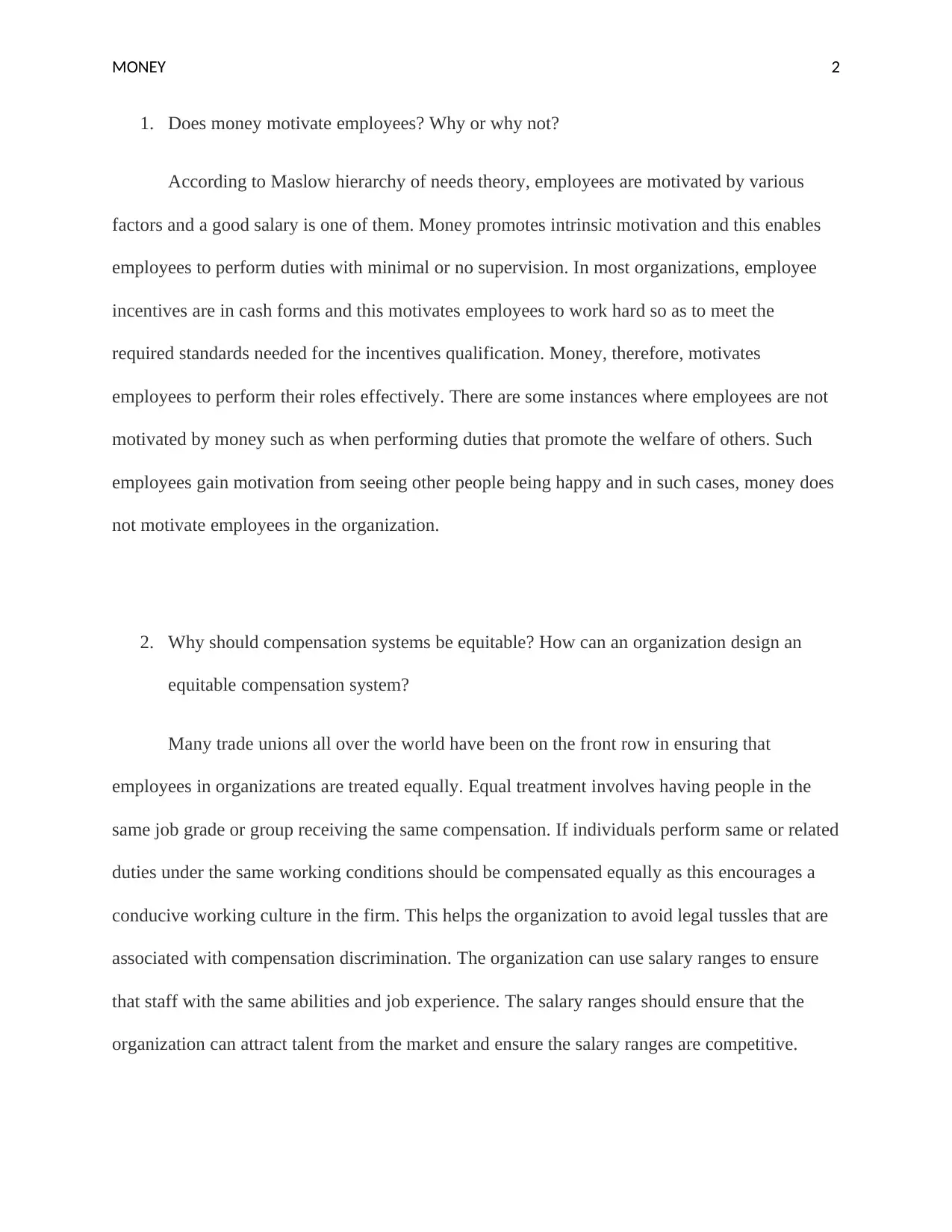
MONEY 2
1. Does money motivate employees? Why or why not?
According to Maslow hierarchy of needs theory, employees are motivated by various
factors and a good salary is one of them. Money promotes intrinsic motivation and this enables
employees to perform duties with minimal or no supervision. In most organizations, employee
incentives are in cash forms and this motivates employees to work hard so as to meet the
required standards needed for the incentives qualification. Money, therefore, motivates
employees to perform their roles effectively. There are some instances where employees are not
motivated by money such as when performing duties that promote the welfare of others. Such
employees gain motivation from seeing other people being happy and in such cases, money does
not motivate employees in the organization.
2. Why should compensation systems be equitable? How can an organization design an
equitable compensation system?
Many trade unions all over the world have been on the front row in ensuring that
employees in organizations are treated equally. Equal treatment involves having people in the
same job grade or group receiving the same compensation. If individuals perform same or related
duties under the same working conditions should be compensated equally as this encourages a
conducive working culture in the firm. This helps the organization to avoid legal tussles that are
associated with compensation discrimination. The organization can use salary ranges to ensure
that staff with the same abilities and job experience. The salary ranges should ensure that the
organization can attract talent from the market and ensure the salary ranges are competitive.
1. Does money motivate employees? Why or why not?
According to Maslow hierarchy of needs theory, employees are motivated by various
factors and a good salary is one of them. Money promotes intrinsic motivation and this enables
employees to perform duties with minimal or no supervision. In most organizations, employee
incentives are in cash forms and this motivates employees to work hard so as to meet the
required standards needed for the incentives qualification. Money, therefore, motivates
employees to perform their roles effectively. There are some instances where employees are not
motivated by money such as when performing duties that promote the welfare of others. Such
employees gain motivation from seeing other people being happy and in such cases, money does
not motivate employees in the organization.
2. Why should compensation systems be equitable? How can an organization design an
equitable compensation system?
Many trade unions all over the world have been on the front row in ensuring that
employees in organizations are treated equally. Equal treatment involves having people in the
same job grade or group receiving the same compensation. If individuals perform same or related
duties under the same working conditions should be compensated equally as this encourages a
conducive working culture in the firm. This helps the organization to avoid legal tussles that are
associated with compensation discrimination. The organization can use salary ranges to ensure
that staff with the same abilities and job experience. The salary ranges should ensure that the
organization can attract talent from the market and ensure the salary ranges are competitive.
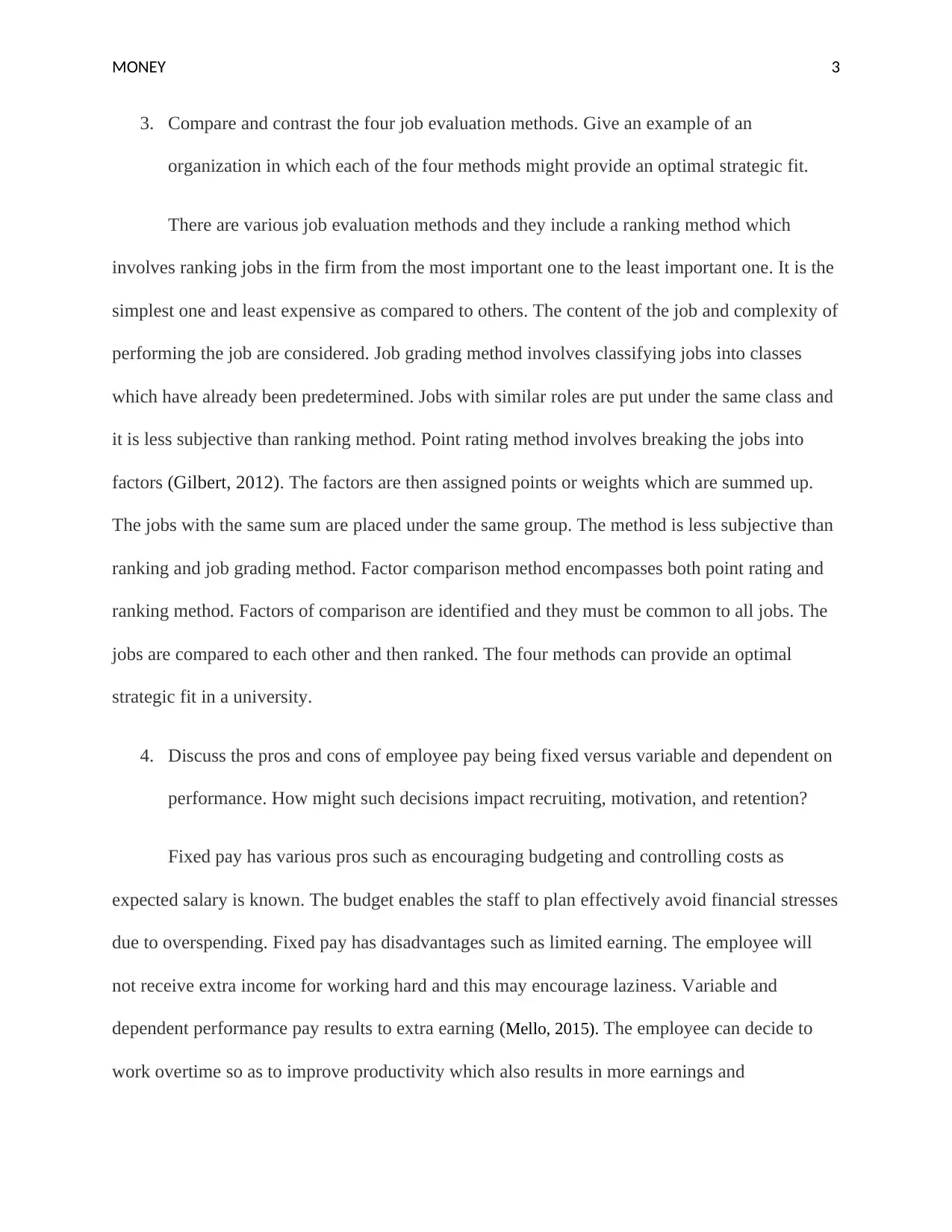
MONEY 3
3. Compare and contrast the four job evaluation methods. Give an example of an
organization in which each of the four methods might provide an optimal strategic fit.
There are various job evaluation methods and they include a ranking method which
involves ranking jobs in the firm from the most important one to the least important one. It is the
simplest one and least expensive as compared to others. The content of the job and complexity of
performing the job are considered. Job grading method involves classifying jobs into classes
which have already been predetermined. Jobs with similar roles are put under the same class and
it is less subjective than ranking method. Point rating method involves breaking the jobs into
factors (Gilbert, 2012). The factors are then assigned points or weights which are summed up.
The jobs with the same sum are placed under the same group. The method is less subjective than
ranking and job grading method. Factor comparison method encompasses both point rating and
ranking method. Factors of comparison are identified and they must be common to all jobs. The
jobs are compared to each other and then ranked. The four methods can provide an optimal
strategic fit in a university.
4. Discuss the pros and cons of employee pay being fixed versus variable and dependent on
performance. How might such decisions impact recruiting, motivation, and retention?
Fixed pay has various pros such as encouraging budgeting and controlling costs as
expected salary is known. The budget enables the staff to plan effectively avoid financial stresses
due to overspending. Fixed pay has disadvantages such as limited earning. The employee will
not receive extra income for working hard and this may encourage laziness. Variable and
dependent performance pay results to extra earning (Mello, 2015). The employee can decide to
work overtime so as to improve productivity which also results in more earnings and
3. Compare and contrast the four job evaluation methods. Give an example of an
organization in which each of the four methods might provide an optimal strategic fit.
There are various job evaluation methods and they include a ranking method which
involves ranking jobs in the firm from the most important one to the least important one. It is the
simplest one and least expensive as compared to others. The content of the job and complexity of
performing the job are considered. Job grading method involves classifying jobs into classes
which have already been predetermined. Jobs with similar roles are put under the same class and
it is less subjective than ranking method. Point rating method involves breaking the jobs into
factors (Gilbert, 2012). The factors are then assigned points or weights which are summed up.
The jobs with the same sum are placed under the same group. The method is less subjective than
ranking and job grading method. Factor comparison method encompasses both point rating and
ranking method. Factors of comparison are identified and they must be common to all jobs. The
jobs are compared to each other and then ranked. The four methods can provide an optimal
strategic fit in a university.
4. Discuss the pros and cons of employee pay being fixed versus variable and dependent on
performance. How might such decisions impact recruiting, motivation, and retention?
Fixed pay has various pros such as encouraging budgeting and controlling costs as
expected salary is known. The budget enables the staff to plan effectively avoid financial stresses
due to overspending. Fixed pay has disadvantages such as limited earning. The employee will
not receive extra income for working hard and this may encourage laziness. Variable and
dependent performance pay results to extra earning (Mello, 2015). The employee can decide to
work overtime so as to improve productivity which also results in more earnings and
⊘ This is a preview!⊘
Do you want full access?
Subscribe today to unlock all pages.

Trusted by 1+ million students worldwide
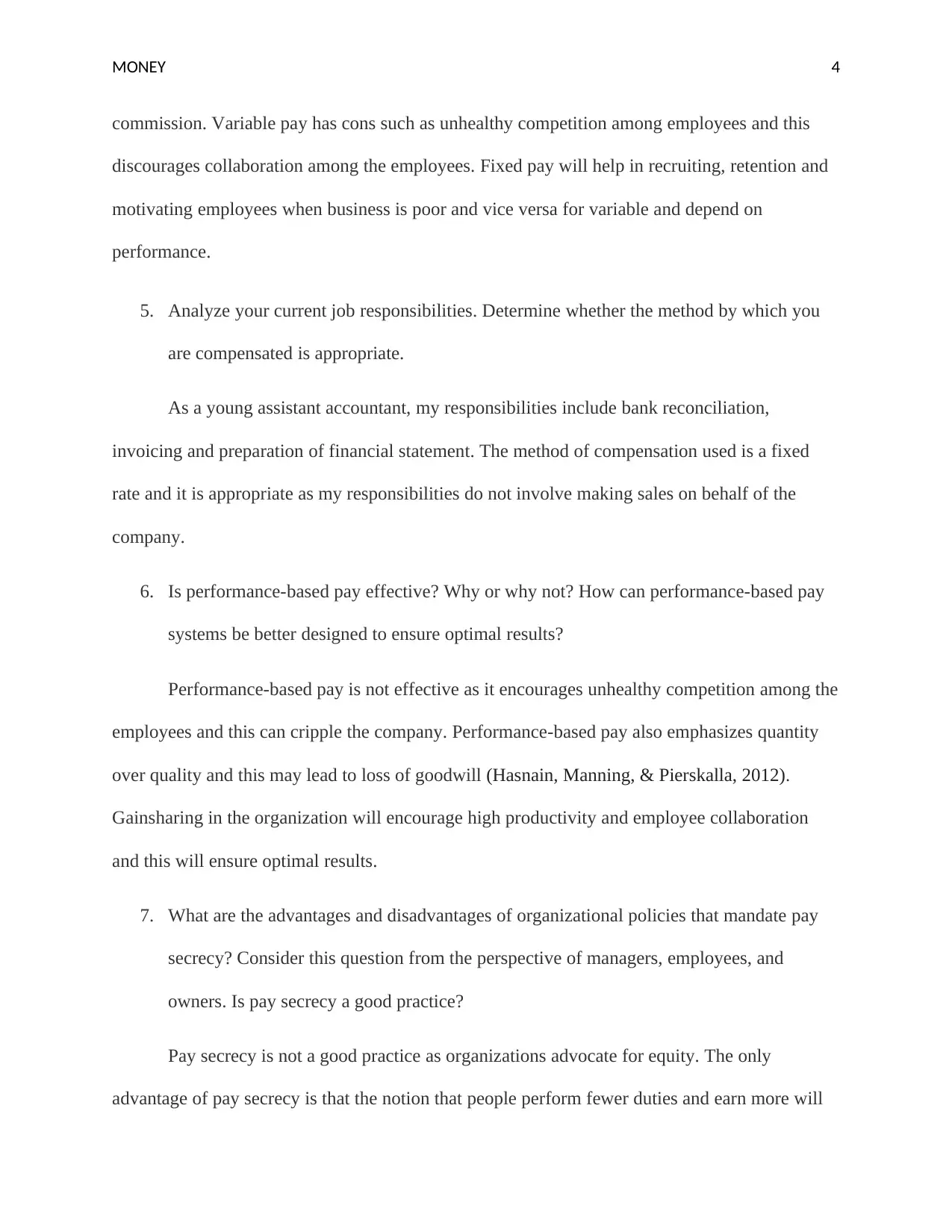
MONEY 4
commission. Variable pay has cons such as unhealthy competition among employees and this
discourages collaboration among the employees. Fixed pay will help in recruiting, retention and
motivating employees when business is poor and vice versa for variable and depend on
performance.
5. Analyze your current job responsibilities. Determine whether the method by which you
are compensated is appropriate.
As a young assistant accountant, my responsibilities include bank reconciliation,
invoicing and preparation of financial statement. The method of compensation used is a fixed
rate and it is appropriate as my responsibilities do not involve making sales on behalf of the
company.
6. Is performance-based pay effective? Why or why not? How can performance-based pay
systems be better designed to ensure optimal results?
Performance-based pay is not effective as it encourages unhealthy competition among the
employees and this can cripple the company. Performance-based pay also emphasizes quantity
over quality and this may lead to loss of goodwill (Hasnain, Manning, & Pierskalla, 2012).
Gainsharing in the organization will encourage high productivity and employee collaboration
and this will ensure optimal results.
7. What are the advantages and disadvantages of organizational policies that mandate pay
secrecy? Consider this question from the perspective of managers, employees, and
owners. Is pay secrecy a good practice?
Pay secrecy is not a good practice as organizations advocate for equity. The only
advantage of pay secrecy is that the notion that people perform fewer duties and earn more will
commission. Variable pay has cons such as unhealthy competition among employees and this
discourages collaboration among the employees. Fixed pay will help in recruiting, retention and
motivating employees when business is poor and vice versa for variable and depend on
performance.
5. Analyze your current job responsibilities. Determine whether the method by which you
are compensated is appropriate.
As a young assistant accountant, my responsibilities include bank reconciliation,
invoicing and preparation of financial statement. The method of compensation used is a fixed
rate and it is appropriate as my responsibilities do not involve making sales on behalf of the
company.
6. Is performance-based pay effective? Why or why not? How can performance-based pay
systems be better designed to ensure optimal results?
Performance-based pay is not effective as it encourages unhealthy competition among the
employees and this can cripple the company. Performance-based pay also emphasizes quantity
over quality and this may lead to loss of goodwill (Hasnain, Manning, & Pierskalla, 2012).
Gainsharing in the organization will encourage high productivity and employee collaboration
and this will ensure optimal results.
7. What are the advantages and disadvantages of organizational policies that mandate pay
secrecy? Consider this question from the perspective of managers, employees, and
owners. Is pay secrecy a good practice?
Pay secrecy is not a good practice as organizations advocate for equity. The only
advantage of pay secrecy is that the notion that people perform fewer duties and earn more will
Paraphrase This Document
Need a fresh take? Get an instant paraphrase of this document with our AI Paraphraser
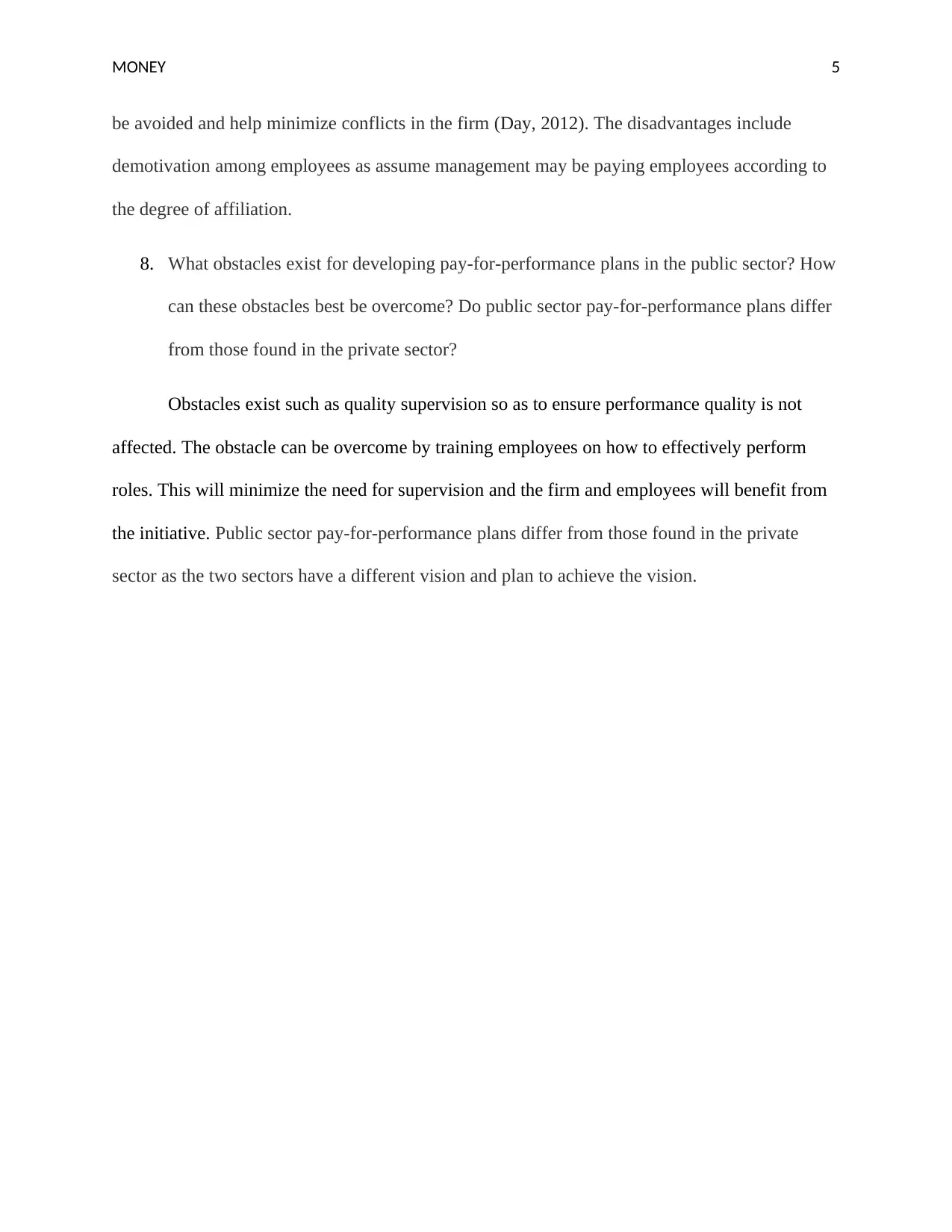
MONEY 5
be avoided and help minimize conflicts in the firm (Day, 2012). The disadvantages include
demotivation among employees as assume management may be paying employees according to
the degree of affiliation.
8. What obstacles exist for developing pay-for-performance plans in the public sector? How
can these obstacles best be overcome? Do public sector pay-for-performance plans differ
from those found in the private sector?
Obstacles exist such as quality supervision so as to ensure performance quality is not
affected. The obstacle can be overcome by training employees on how to effectively perform
roles. This will minimize the need for supervision and the firm and employees will benefit from
the initiative. Public sector pay-for-performance plans differ from those found in the private
sector as the two sectors have a different vision and plan to achieve the vision.
be avoided and help minimize conflicts in the firm (Day, 2012). The disadvantages include
demotivation among employees as assume management may be paying employees according to
the degree of affiliation.
8. What obstacles exist for developing pay-for-performance plans in the public sector? How
can these obstacles best be overcome? Do public sector pay-for-performance plans differ
from those found in the private sector?
Obstacles exist such as quality supervision so as to ensure performance quality is not
affected. The obstacle can be overcome by training employees on how to effectively perform
roles. This will minimize the need for supervision and the firm and employees will benefit from
the initiative. Public sector pay-for-performance plans differ from those found in the private
sector as the two sectors have a different vision and plan to achieve the vision.
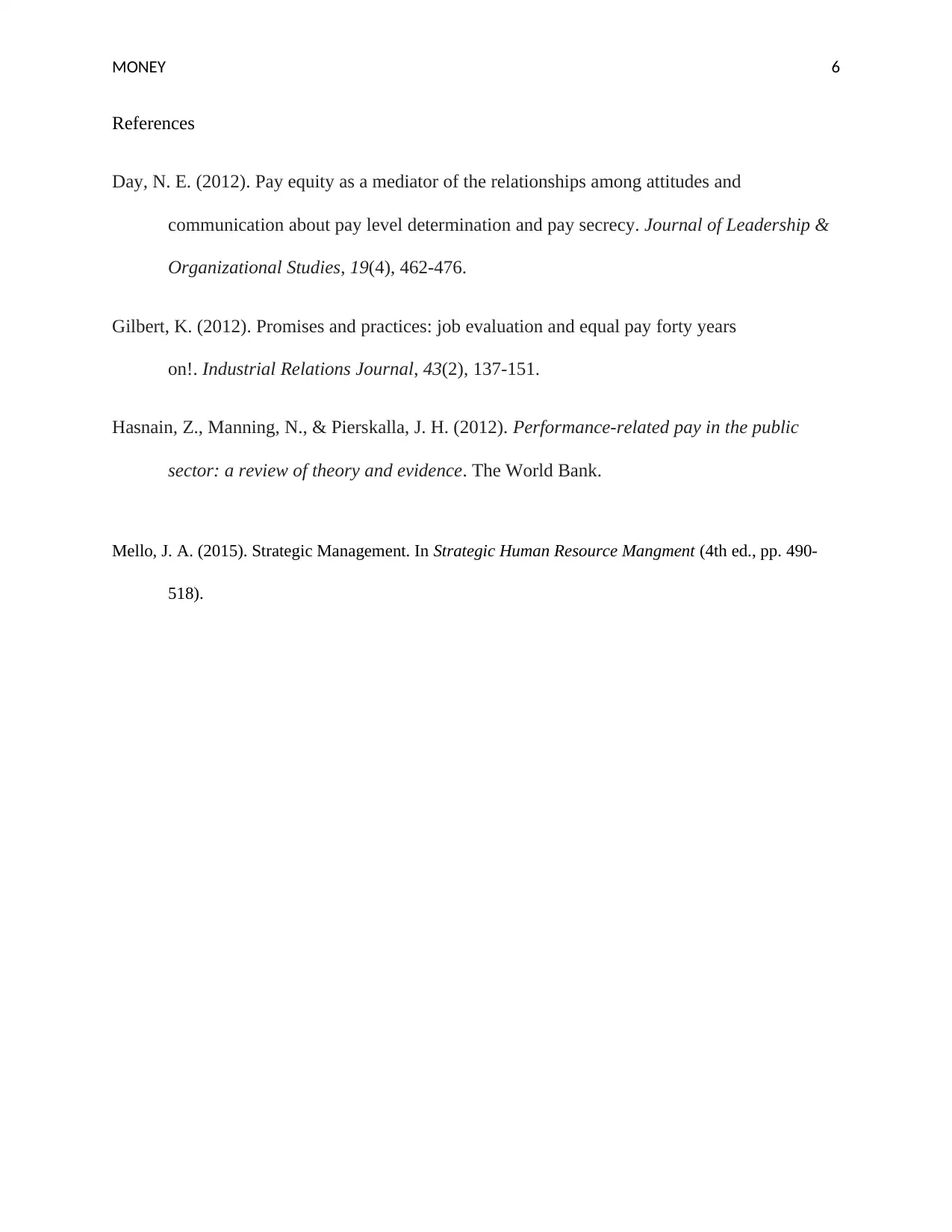
MONEY 6
References
Day, N. E. (2012). Pay equity as a mediator of the relationships among attitudes and
communication about pay level determination and pay secrecy. Journal of Leadership &
Organizational Studies, 19(4), 462-476.
Gilbert, K. (2012). Promises and practices: job evaluation and equal pay forty years
on!. Industrial Relations Journal, 43(2), 137-151.
Hasnain, Z., Manning, N., & Pierskalla, J. H. (2012). Performance-related pay in the public
sector: a review of theory and evidence. The World Bank.
Mello, J. A. (2015). Strategic Management. In Strategic Human Resource Mangment (4th ed., pp. 490-
518).
References
Day, N. E. (2012). Pay equity as a mediator of the relationships among attitudes and
communication about pay level determination and pay secrecy. Journal of Leadership &
Organizational Studies, 19(4), 462-476.
Gilbert, K. (2012). Promises and practices: job evaluation and equal pay forty years
on!. Industrial Relations Journal, 43(2), 137-151.
Hasnain, Z., Manning, N., & Pierskalla, J. H. (2012). Performance-related pay in the public
sector: a review of theory and evidence. The World Bank.
Mello, J. A. (2015). Strategic Management. In Strategic Human Resource Mangment (4th ed., pp. 490-
518).
⊘ This is a preview!⊘
Do you want full access?
Subscribe today to unlock all pages.

Trusted by 1+ million students worldwide
1 out of 6
Related Documents
Your All-in-One AI-Powered Toolkit for Academic Success.
+13062052269
info@desklib.com
Available 24*7 on WhatsApp / Email
![[object Object]](/_next/static/media/star-bottom.7253800d.svg)
Unlock your academic potential
Copyright © 2020–2025 A2Z Services. All Rights Reserved. Developed and managed by ZUCOL.





